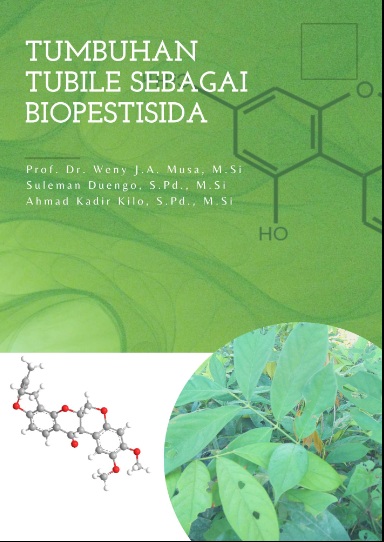Isolasi Dan Identifikasi Senyawa Metabolit Sekunder Ekstrak Etil Asetat Daun Sambiloto
Authors: Nurhayati Bialangi, Reski Rahmatia Idris, Akram La Kilo, Ahmad Kadir Kilo
Penelitian ini bertujuan untuk mengisolasi dan mengidentifikasi senyawa metabolit sekunder ekstrak etil asetat dari daun sambiloto. Isolasi tersebut dilakukan melalui tahap maserasi, fraksinasi, dan kromatografi. Identifikasi ekstrak tersebut dan isolatnya dilakukan dengan cara uji fitokimia, spektrofotometer-UV Vis, dan IR. Daun sambiloto kering sebanyak 633 gram dimaserasi dengan metanol selama 3× 24 jam, dan diperoleh ekstrak kental metanol setelah melalui proses evaporasi. Ekstrak tersebut difraksinasi berturut-turut dengan n-heksana dan etil asetat untuk menghasilkan ekstrak kental etil asetat sebanyak 21, 99 gram. Kemudian, ekstrak kental etil asetat dipisahkan dengan kromatografi kolom dan diuji kemurniannya dengan KLT dan diperoleh isolat murni yang berupa kristal putih dengan berat 126, 3 mg. Hasil uji fitokimia ekstrak etil asetat menunjukkan bahwa daun sambiloto mengandung flavanoid.
Tumbuhan Tubile Sebagai Biopestisida
Lead Metal in Water and Sediment: A Case Study of Rumbia River
Authors: Deasy Natalia Botutihe, Sri Wanti Sappe, Ahmad Kadir Kilo, Jafar La Kilo, Akram La Kilo
The purpose of this study was to determine and analyze the levels of leadcontained in the water and sediments of the Rumbia River. This research was conducted in a quantitative manner. Lead levels were measured using Atomic Absorption Spectrophotometer (SSA) of Simatzu AA 500. The results showed that the leadcontent in Rumbia River water for point A1 was undetectable whereas point 2 and 3 were 0.001 mg/kg. In sediments, at point A1 is 1.8 mg/kg and at points 2 and 3 were 0.9 mg/kg. The level of Pb in Rumbia River water is still below the water quality standard limit for marine biota determined by the Ministry of Environment No. 51 of 2004. Similarly, lead levels in sediments are below the threshold standard for sediment quality based on sediment quality guidelines for metals and associated levels of concern to be used in doing assessments of sediment quality. In general, it can be said that the concentration of lead in the Rumbia River is still at a harmless level. However, socio-economic conditions that continue to change over time can cause changes in the level of water pollution. So there needs to be an effort and public awareness in maintaining the occurrence of increased levels of pollutants in the Rumbia River.
Diagnosa Miskonsepsi Siswa SMA Negeri 1 Telaga Gorontalo pada Materi Termokimia
Authors: Mangara Sihaloho, Sutra S Hadis, Ahmad Kadir Kilo, Akram La Kilo
Vol 3, No 1 (2021): Jambura Journal of Educational Chemistry
Alkaloid compound from Tombili (Caesalpinia bonduc) as biopesticide agent on rice plants
Authors: Weny JA Musa, Suleman Duengo, Ahmad Kadir Kilo, Boima Situmeang
The purpose of these study is to determine the effect of active compound from tombili seed extract as a vegetable pesticide in the prevention of soil pest in rice plants. The method of these researches is isolation to obtain pure isolates, characterization by using infrared spectrophotometer (IR) and UV-VIS spectrophotometer then following biological test. The isolates obtained were tested positive for phytochemical containing alkaloid compounds and characterized as amorphous crystals. Identification of IR spectrophotometer generate a functioning-NH wave group of the wavelengths region of 3423.4 cm-1, bend CN at wave number 1242.1 cm-1, CH stretch at wave number 2925.8 and 2854.5 cm-1, bend CH at 1475 wave numbers 1540 cm-1, carbonyl group (C= O) at the 1720.4 cm-1 wave number which is probably an alkaloid compound. The UV-VIS spectrophotometer results in a maximum absorption at 209.9 nm wavelengths indicated the presence of double bonds between the C= O functional group suspected as a result of the successive electronic transitions to n-phi* and n-sigma*. The result of biological test showed that methanol extracts of tombili seed can be used as a vegetable pesticide in pest prevention on rice plants, the most effective concentration used in this biological test is at 0.1% concentration, with very high effectiveness in eradicating pest on rice plants.

